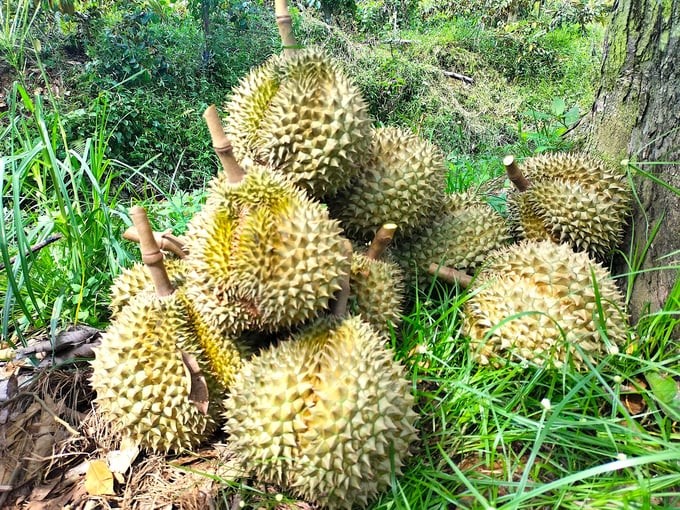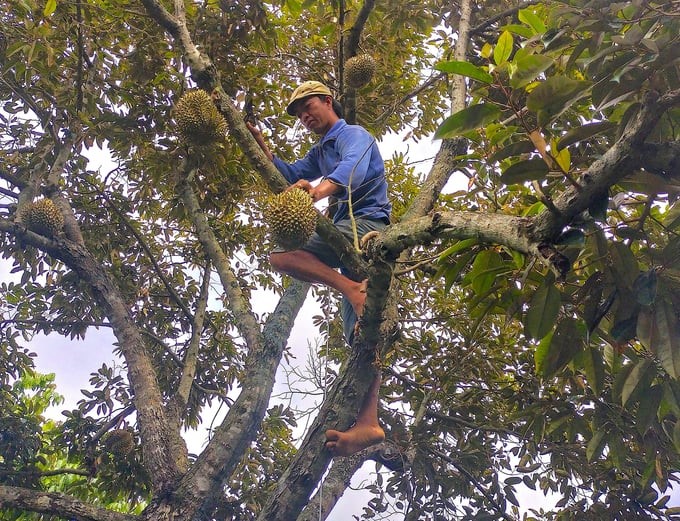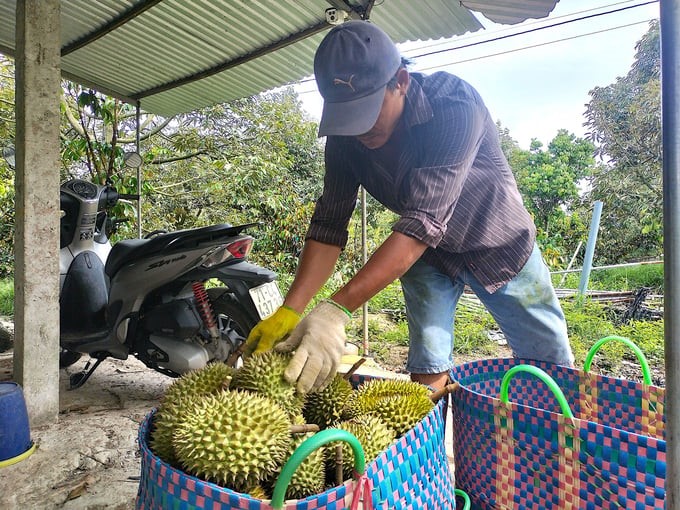November 26, 2025 | 02:23 GMT +7
November 26, 2025 | 02:23 GMT +7
Hotline: 0913.378.918
November 26, 2025 | 02:23 GMT +7
Hotline: 0913.378.918
Currently, export businesses are purchasing durian fruits at extremely high prices. In the Mekong Delta, compared to 1.5 months ago, the flat price of durian increased by about VND 50,000–55,000/kg. The flat price of Ri6 durian in the garden reaches VND 100,000–105,000/kg, while the Thai durian flat price is VND 115,000–120,000/kg.

Currently, the durian fruit price is at a high level. Photo: Minh Dam.
According to traders, durian is being sold well in the Chinese market, but the purchasing volume is low because it is the end of the season. Farmers with this year's durian off-season shared that when the trees flower, there is a lot of rain, so most of them do not fruit.
A high increase in the durian price easily makes farmers impatient to harvest early. Selling young durian without enough age (ripeness) will not only cause damage to farmers but also seriously affect this industry in Vietnam.
Ben Tre province has a durian area of over 2,700 hectares, most concentrated in Chau Thanh district. This locality has a durian area of about 1,300 hectares, grown in the communes of Tan Phu, Phu Duc, Tien Long, etc. In order to improve the quality of durian in growing areas for export, Mr. Nguyen Van Quoc, Deputy Head of the Chau Thanh Department of Agriculture and Rural Development, said: "Previously, the district also focused on disseminating farmers not to sell young durian and strengthening coordination to develop growing area codes and implement scientific and technical transfer in durian production."
In the growing area of Tan Phu Cooperative (Tan Phu commune, Chau Thanh district, Ben Tre), farmer Nguyen Huu Thiet said that in the past, the locality had a situation of people listening to traders and selling young durian without enough age. When traders cannot sell those young durian fruits in the market, they come back to reduce prices, leave deposits, and refuse buying for people. Now, farmers in Tan Phu no longer sell young durians. They were aware of the above-mentioned issue.

The Ben Tre Department of Agriculture and Rural Development recommends gardeners be in no hurry to harvest durian early when the price increases highly. Photo: Minh Dam.
According to the Ben Tre Department of Agriculture and Rural Development, in recent years, Vietnam’s durian has grown rapidly in both area, output, and export turnover value. In July 2022, Vietnamese durian fruits were officially exported to the Chinese market. This is a great opportunity for this commodity, so the durian area continues to increase.
In the growing area of Tan Phu Cooperative (Tan Phu commune, Chau Thanh district, Ben Tre), farmer Nguyen Huu Thiet said that in the past, the locality had a situation of people listening to traders and selling young durian without enough age. When traders cannot sell those young durian fruits in the market, they come back to reduce prices, leave deposits, and refuse buying for people. Now, farmers in Tan Phu no longer sell young durians. They were aware of the above-mentioned issue.
Ben Tre Department of Agriculture and Rural Development requested the People's Committees of Cho Lach, Chau Thanh, and Mo Cay Bac districts to direct district branches and organizations to disseminate information and recommend that when harvesting durian, farmers ensure enough ripeness to meet the domestic and export market requirements; avoid harvesting young durians that are not ripe enough.
In addition, direct the Department of Agriculture and Rural Development and People's Committees of communes with durian production to strengthen durian farming techniques and solutions, especially techniques of flower and fruit pruning and durian harvesting, according to Decision No. 362.
The Department of Agriculture and Rural Development also directed the Sub-Department of Crop Production and Plant Protection, the Provincial Center for Agricultural Extension and Agricultural Service Consulting to coordinate with localities to deploy training on temporary processes of flower and fruit pruning and durian harvesting techniques according to Decision No. 362. In particular, it is necessary to guide farmers to produce durian that meets market requirements.

This year's off-season is not favorable. Durian output is low while prices increase highly. Photo: Minh Dam.
In addition, the units also need to increase the dissemination and application of good agricultural practices (GAP) and integrated plant health management (IPHM) in durian production areas; focus on and ensure quality; and ensure food safety. At the same time, strengthen coordination with localities in developing growing area codes and packaging facility codes for export. Carry out inspection, management, and use of assigned growing area codes and packaging facility codes in accordance with regulations.
As for organizations, businesses, cooperative groups, and cooperatives participating in developing durian growing area codes and packing facility codes, the Ben Tre Department of Agriculture and Rural Development requests to continue supporting and linking with durian farmers and properly implementing the temporary process of flower and fruit pruning and durian harvesting techniques. Organize production and form concentrated, long-term, stable linked raw material areas; establish and use codes for growing areas and packaging facilities eligible for export; and purchase, process, and consume products effectively.
Translated by Huyen Vu Thu
/2025/11/24/3616-2-141832_513.jpg)
(VAN) FSC certification has helped increase the value of thousands of hectares of planted forest timber under the management of the Xuan Loc Protection Forest Management Board, particularly in terms of selling prices.

(VAN) More than 100 shoppers queued for a chance to get a kilo or so of Japanese rice for 500 yen ($3.32) by heaping as much grain into a small wooden box as possible.

(VAN) Benchmark international prices of milled declined in October as harvests started or improved in some parts of the globe.

(VAN) Show cause orders will be issued to retailers who sell imported rice at prices exceeding the maximum suggested retail price (MSRP) of P43 per kilo, Philippines Agriculture Secretary said in a statement on Thursday.

(VAN) Coffee prices on October 20, 2025, remained stable domestically, trading at 113,500–114,500 VND/kg. Similarly, global coffee prices also moved sideways.

(VAN) By October, Vietnam’s coffee exports had surpassed USD 7 billion for the first time and will exceed USD 8 billion within this year.

(VAN) Illinois rancher says Texas, Oklahoma, Kansas lost grass and forage, forcing massive cattle liquidation.